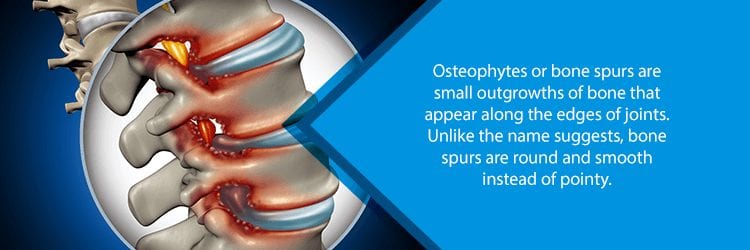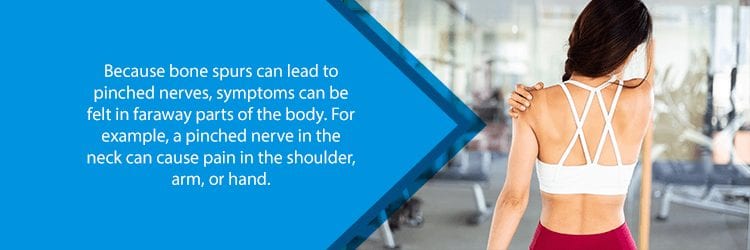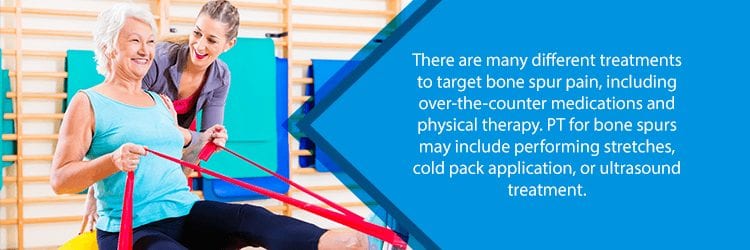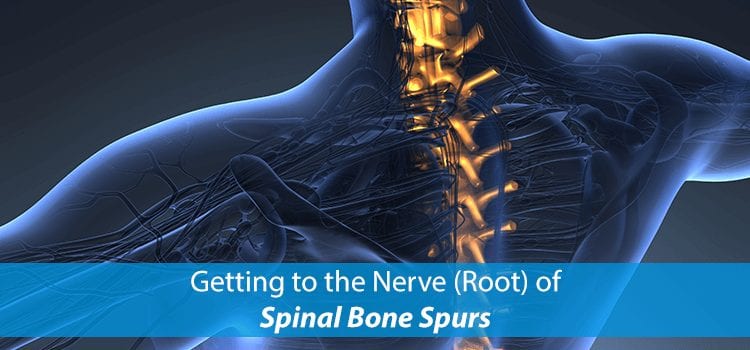Bone spurs, or osteophytes, are small outgrowths of bone that appear along the edges of our bones. Typically, these structures develop over time, usually forming at the joints in various places throughout the body. For example, bone spurs may pop up in the hands, spine, hips, shoulders, knees, feet, and much more.
Despite what most may think, bone spurs are actually round and smooth—not rigid or rough around the edges as the name might suggest. Additionally, not all bone spurs cause symptoms. A patient may be walking around with bone spurs at any point in his or her body without experiencing any problems whatsoever. Bone spurs only tend to hurt in cases where they press on adjacent nerves or rub against other structures. In such instances, the patient may also experience stiffness in addition to pain.
Bone spurs are most common in patients who are age 60 or older. Unfortunately, a good chunk of osteophyte cases will require treatment. Studies estimate that roughly 40% of people with bone spurs must seek out medical consultation for the condition.

Why Spinal Bone Spurs Occur
Bone spurs usually form when something goes awry surrounding a joint in the body. The most common cause for osteophytes is osteoarthritis, which is a degenerative disease that wears down joint cartilage.
Cartilage is a protective structure, and when it goes away, the bones become much more vulnerable to inflammation and other structural changes. The lack of cartilage leads to the thickening of ligaments, as well as the formation of calcium deposits. This leads to excessive bone growth, which is what ultimately causes bone spurs.
In essence, bone spurs are like the joint’s natural reaction to overexposure. Spurs form as a means to increase the surface area of a vulnerable joint. This reduces pinpoint pressures that outside forces apply to the joint each day. Although this seems like it would be a good thing, it sadly does not pan out that way. Instead, this process ends up reducing the mobility of the joint in addition to compressing nearby nerves and soft tissues.
Bone spurs may also form from diffuse idiopathic skeletal hyperostosis (DISH). This is a non-inflammatory disease with an unknown cause. However, those who do have the condition have a very high chance of forming bone spurs along the spine. In fact, 80% of patients with DISH will experience painful symptoms as a direct result of spinal bone spur formation.
Symptoms of Osteophytes
In the vast majority of cases, bone spurs are inconsequential, causing no painful symptoms whatsoever. These structures may form in a variety of places, which may affect how symptoms manifest. For example, when bone spurs occur in the fingers, there may be small visible bumps along the joints. Typically speaking, if symptoms do occur, then they are most likely to occur in patients who are age 60 or older. In patients who are age 60 and older, roughly 40% of people will require medical treatment for osteophytes.
Bone spurs may also occur in the knee, which may make it difficult for the patient to extend the leg. Additionally, bone spurs may appear in the shoulder, which sometimes causes inflammation and swelling in the rotator cuff joint. Bone spurs sometimes show up in the hips, which can limit movement and may lead to painful bone spur symptoms.
Of course, these are just a few examples of places where bone spurs might occur. All things considered, the most common occurrence of bone spurs is in the spine. Bone spurs in the spine have the widest range of symptoms, as they may press on adjacent nerve roots or the spinal cord itself. As you might imagine, this leads to obvious symptoms such as pain and numbness, but the interesting tidbit here is that these symptoms may also become present in other places of the body. For example, the pain may radiate down a path toward the arms or legs, and there may be accompanying sensations of pins and needles.
If you experience joint pain or stiffness that does not go away within a couple of days, then you may want to seek out medical help.

How Are Spinal Bone Spurs Diagnosed?
Usually, your general practitioner will be the first person to suggest that you have bone spurs. He or she will most likely refer you to a specialist, such as an orthopedic doctor or a rheumatologist for further treatment. The former specializes in the musculoskeletal system, whereas the latter focuses more on joint problems. Either way, your doctor will feel the affected area to check for bumps.
Before your doctor orders any tests, he or she will need to evaluate your medical history. You will need to provide your doctor with a description of your current symptoms. Depending on the location of the joint, your doctor will feel around the affected area to search for any joint abnormalities.
If your doctor suspects that you have bone spurs, he or she may order the following tests:
- X-Ray Imaging: This is one of the most common tests and doctors use it to help better visualize your bone spurs.
- CT Scan: CT Scans are essentially more powerful x-ray images that show highly detailed pictures of the inside of your body.
- MRI: This test involves a machine that uses powerful magnets and radio waves to emit images of organs and other structures inside your body.
- Electroconductive Tests: These tests measure the speed at which your nerves transmit signals throughout the body. This may also show damages that were a direct result of bone spurs in the spinal canal.

Spinal Bone Spur Treatments
To reiterate, most of the time bone spurs do not cause any symptoms and therefore require no medical treatment. That being said, if they do cause symptoms they may vary in severity. For example, if a bone spur only causes mild discomfort every now and then, then your doctor may suggest trying over-the-counter pain medicines. In some instances, your doctor may also recommend steroid shots to reduce swelling and inflammation, however, this solution is only temporary. Additionally, it may take multiple steroid administrations to the same joint over a period of one year.
Physical therapy is another effective treatment for bone spurs when it focuses on the muscles surrounding the affected area. Of course, this does not get rid of the bone spurs, but it may reduce symptoms such as a loss of joint motion. Physical therapy may involve a variety of different stretches, cold pack application, and ultrasound treatments.
In rare instances, your doctor may recommend surgery for your bone spurs. Usually, your doctor will only consider this option after all other conservative methods have been exhausted. For spinal bone spurs, your surgeon will usually insert a special type of spacer into the affected vertebrae to prevent nearby nerve compression. In other instances, your doctor may recommend arthroscopic surgery. Consult with your doctor to find out what procedure best suits your specific needs.
Contact Us
If you are experiencing joint pain that persists over a period of time, consider contacting our practice at (855) 586-2615. Our doctors are passionate about finding a treatment plan that works for your case and suits your specific needs. The medical staff at NJ Spine and Orthopedic is dedicated to providing the latest in minimally invasive technologies and conservative treatments for our patients. Don’t hesitate, contact us today!

